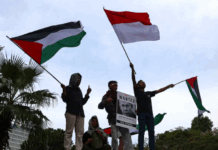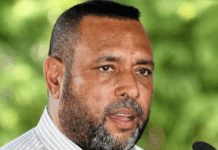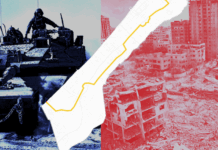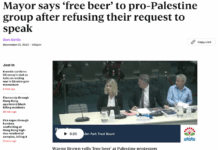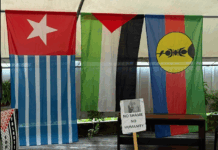Researchers in Bonn warn Pacific Islanders may be among the first to be forced to migrate due to climate change, as sea level rise threatens to make whole islands uninhabitable. Video: Democracy Now!
At least 23 million people were displaced by extreme weather as a result of climate change.
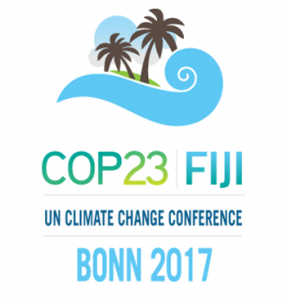 “If we act now in terms of climate change action, … it means we support for people to stay in their homes. … Let’s not make migration a last resort, a tragedy,” says Dina Ionesco, the head of migration, environment and climate change at the International Organisation for Migration.
“If we act now in terms of climate change action, … it means we support for people to stay in their homes. … Let’s not make migration a last resort, a tragedy,” says Dina Ionesco, the head of migration, environment and climate change at the International Organisation for Migration.
Transcript
AMY GOODMAN: We are broadcasting live from the UN climate summit in Bonn.
NERMEEN SHAIKH: This year is known as the first “Islands COP,” with Fiji presiding over this year’s summit. The event itself is being held here in Bonn because of the logistical challenges of hosting thousands of people in Fiji at the start of the South Pacific cyclone season. Researchers here at Bonn are warning that Pacific Islanders may be among the first to be forced to migrate due to climate change, as sea level rise is threatening to make whole islands uninhabitable.
AMY GOODMAN: Well, we got a chance to speak with Pacific Islanders who rolled out a red carpet to greet German Chancellor Angela Merkel here at the COP23. The massive banner that went along the floor to the plenary read “Keep it in the ground.” Among those who rolled it out were Pacific warriors Joseph-Zane Sikulu of Tonga and Lusia Feagaiga, a delegate from Samoa. I asked them how climate change is affecting their islands.
LUSIA FEAGAIGA: With the sea levels rising, a lot of our lower-lying atoll countries are being affected. I mean, Marshall Islands is two meters above sea level; Tuvalu, probably three. And once king tides come in, it’s most likely that their villages will be flooded with saltwater because of the rising sea levels. Even in Samoa, places where families, their ancestral homes used to be on the shore, now have to be moved further inland because of the rising sea level. So, it’s affecting way of life. It’s affecting crops and indigenous root crops, because of saltwater intrusion, as well as fresh drinking supplies, as well.
AMY GOODMAN: But island nations are not the only places where climate change is threatening to force people from their homes. Last year, around the world, at least 23 million people were displaced by extreme weather.
For more, we’re joined by Dina Ionesco, the head of migration, environment and climate change at the International Organisation for Migration.
So you just heard people from Tonga and Samoa. What do they face? What is a climate change migrant or climate change refugee?
DINA IONESCO: Well, climate change migration means that the impacts of climate change affect so much the lives of people that they can’t stay in their homes. And very often also, climate change connects to other issues—poverty, for instance, or demographic issues or conflict. And it makes it even more difficult for people to remain. So, climate migration means that people have to move, but also sometimes choose to move, because their environment is degrading. And it can mean, as you said, sudden onset, big storms, floods. There, it’s easier to count who moved because of those causes. But it means also the slow onset, like desertification, sea level rise, land loss. So it’s very complex, many different issues. But the bottom line is that we maybe do not want these people to be forced to move because of climate change. So, this was why we are here.
Climate refugees
NERMEEN SHAIKH: Well, a few years ago, a man from the island of Kiribati sparked a global debate because he became the first person ever to seek asylum, for him and his family, as climate refugees. So could you tell us about his case and what’s happened with people seeking asylum for climate-related issues?
DINA IONESCO: So, we have to realise that the majority of people who move because of climate change, they move internally. They move within borders. So that means they are under the responsibility of their own states. They are not seeking a climate refugee status, because their own state has to take care of them and respect their human rights. There are some cases—we had the case for these small islands or for Haiti after the earthquake—where people move to across borders, maybe to Brazil or to the US or just across within the same island. And then there’s the question: What right do they have to move, to stay? And there, there are also possibilities to give them a humanitarian visa or a temporary protection that can allow them to stay. You can’t be a refugee for the moment. Maybe it will be, but we don’t know that. It’s very difficult to create a status as a refugee for climate change.
AMY GOODMAN: But what do you think it’s most important for the world to know right now about what the world is doing about climate migrants?
DINA IONESCO: I think one key thing to realize is that if we act now in terms of climate change action, if we take care of the Earth now, it means we support for people to stay in their homes, that they are not forced to migrate. So that’s one key message we have to say. Invest in climate action. It gives people a choice whether to go. They have the right to move if they want to move, but let’s not make migration a last resort, a tragedy, when it’s too late, when there’s nothing else.
AMY GOODMAN: Well, Dina Ionesco, we thank you so much.



